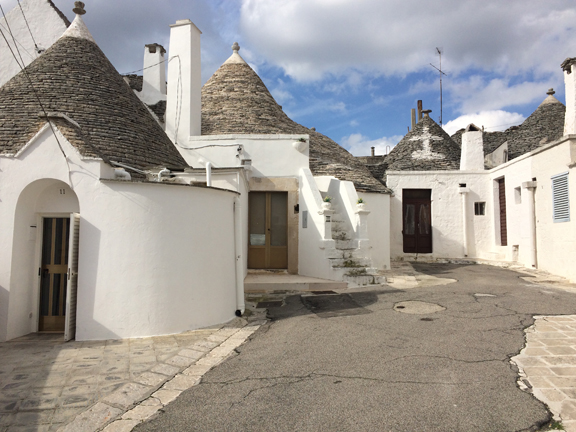Unusual Houses in Puglia
I mean it. Really. Have you ever seen a house you wanted to hug?
That's exactly what I wanted to do upon first seeing a trullo: I wanted to hug it!
Alborobello is a World Heritage Site
Travelling a bit more than hour from our home-base in Lecce (Puglia) is Alborobello, a UNESCO world heritage cite. It is a city put on the map by its trulli. All around this area, you can find trulli scattered throughout the countryside. In Alborobello, one finds their densest concentration.The route to Alborobello from Lecce is interesting, presenting a change from flat to hilly to steeper and greener terrain, with winding mountain passes that get snow (I saw road signs warning of its eventuality). The area is a distinct change of scenery from further south, and it is home to many nature walks in the woods. It was taking this drive that I realised how much I missed large masses of green and trees. Seems the ancient Romans de-natured the once-forested south of Italy (and Sicily), uprooting the trees to build ships. Ah yes, the lessons of history...
It makes one smile to see a cluster of trulli from a distance. I imagined a whole village of small persons with pointed hats. Not so, of course. The trullo is a unique example of ancient architecture that survives and functions in
today's world. Nowadays, several trulli can be seen joined into quite
fantastic,
castle-like residences with charmingly curved courtyards. There are
trulli hotels, though you can also stay in a small trulli B&B. Their
conical roofs are are made of horizonatal slabs of limestone,
positioned in a series of diminishing concentric circles, and often
mounted by a decorative feature.
 |
| streets of trulli, Arborobello (Janet Strayer photos) |
 |
| trullo roof stones (Janet Strayer photo) |
Inside a Trullo
I wanted to get a feeling for the more modest trullo, as it might have been in the past. One was open for vistors, allowing us to see how remarkable it was inside as well as out. I was amazed by how compact and
comfortable it was. The structure's interior is distributed around its central space without any additional elements of support -- like the modern concept of open-space interior, but with arched ceilings separating modular units in this space. The "rooms" (without doors) are identified by changing curves in the wall, each one mounted by a high
coned ceiling. Standing was comfortable and, though each room was tiny,
each was sufficient to its purpose, explained to me as the central living area, kitchen-dining-area, adult bedroom, children's bedroom. The walls' thickness and the scarcity of windows functions to promote thermal regulation: warm in winter, cool in summer.
History of Trulli Structures
 Trulli have been recorded in archaeological finds as preshistoric burial sites, among other things, and their construction is not complex--- but building them to endure stably is a skill (link to read more). Made of limestone rocks built up concentrically into ever smaller circles, their bases are now grafted with limestone masonry.
Trulli have been recorded in archaeological finds as preshistoric burial sites, among other things, and their construction is not complex--- but building them to endure stably is a skill (link to read more). Made of limestone rocks built up concentrically into ever smaller circles, their bases are now grafted with limestone masonry.But why should they have remained distinctly prominent in this region? Their historical origins as a settlement of houses in Alborobello date back to the 14th century. The story is that this form of construction, known from earliest times, was used because it is free-standing dry wall (no mortar) that can be readily constructed (and dismantled). Those qualities, plus the abundance of white limestone in the area, could serve the needs of hasty settlers, eager to take advantage of land grants while evading building taxes.
Locorotondo
Leaving Alborobello, we made a brief stop in nearly Locorotondo ("round place"), heralded as one of the most beautiful small cities in Italy... and one of the whitest. Some of Italy's fine wines can be found in this area.
Although trulli can also been seen here, my lasting impression of this city is of well cared-for, simple white houses, calmly positioned in a circular city plan.
We stopped for a machiatto at an fine little coffee bar facing the little park atop the city, taking a look down at the scenic valley before continuing "home" to Lecce.
I'm eager to see what comes next. Until then...
I'm eager to see what comes next. Until then...
More Creative Life News
You can read and see more recent posts about Italy plus other travels and creative adventures by this itinerant artist at my Creative Life News site here.





Both cute AND informative. Nice pix, too.
ReplyDeleteYour comments are always so welcome.
ReplyDelete